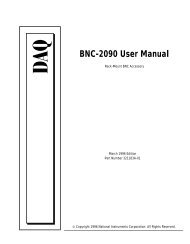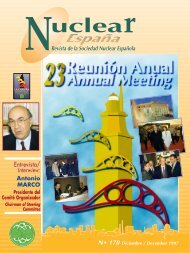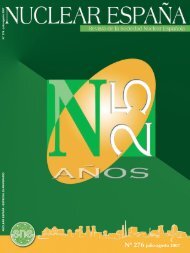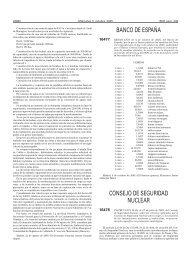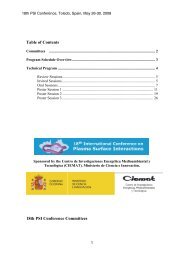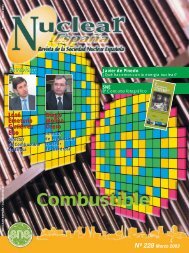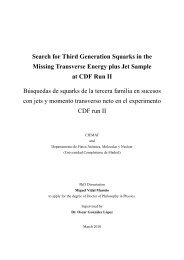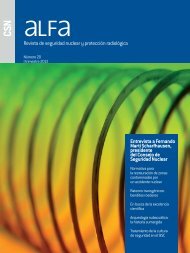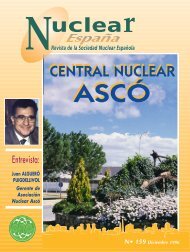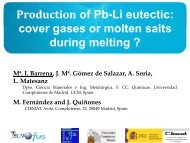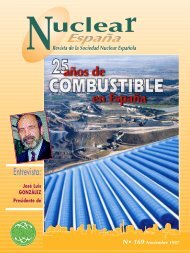EntrEntr evista/evista/ InterInter viewview
EntrEntr evista/evista/ InterInter viewview
EntrEntr evista/evista/ InterInter viewview
You also want an ePaper? Increase the reach of your titles
YUMPU automatically turns print PDFs into web optimized ePapers that Google loves.
that is yielding results in the nuclear industry and that<br />
may contain elements that can be extrapolated to other<br />
industrial sectors.<br />
The importance attached by the nuclear arena to<br />
innovation, to technological research & development, is<br />
not new nor is it the legacy of any organization in<br />
particular, but it does demonstrate the consistency<br />
between its traditional approaches and the current idea<br />
of modernizing the country by promoting a national<br />
technological fabric.<br />
IDENTIFICATION AND DEVELOPMENT OF<br />
TECHNOLOGICAL INNOVATION PROJECTS<br />
The first step to innovating is to know what to do and<br />
for what purpose. Traditionally, terms such as business<br />
knowledge, market surveys and others have been used,<br />
and lately the concept of Technological Monitoring has<br />
become generalized. In any event, it is obvious that to<br />
define and implement innovative actions, an in-depth<br />
analysis of the environment in which the so-called<br />
innovation will be used is required.<br />
In the case that concerns us – nuclear R&D in Spain –<br />
the analysis results indicate that there has been a move<br />
from a regulated situation, in which an acceptable level<br />
of nuclear R&D activity was maintained with a welldefined<br />
organizational plan and with funding<br />
requirements basically covered, to a situation<br />
characterized by competition, organizational<br />
disintegration, funding problems and a slowdown of<br />
research activity that lately seems to be picking up.<br />
Of the trends observed, it should be noted that<br />
deregulation of the sector, modification of R&D funding<br />
conditions, and the need to increase competitiveness<br />
require a certain level of activity and that cooperative<br />
R&D offers advantages over other options, as it makes it<br />
possible to conduct the process in an organized way and<br />
to share risks and costs without detracting from each<br />
organization’s capacity for individual decision-making.<br />
The nuclear business has from the very beginning had<br />
an inevitable international component, and thus the<br />
analysis must seemingly be repeated for the international<br />
arena. In this respect, it should be noted that the sector<br />
has extensive experience in international R&D<br />
collaboration which, with the national technological<br />
level obtained, provides technological and funding<br />
possibilities (under certain conditions). In the current<br />
situation, these collaborations help to partially<br />
compensate for diminished activity by minimizing<br />
technological and economic risks.<br />
As regards the trends observed internationally, it<br />
should be noted that, while maintaining the progressive<br />
evolution of safety improvement, the economic efficiency<br />
factor has become key to maintaining the viability of the<br />
nuclear option on an international scale, thus<br />
overcoming the problems of a reticent public opinion.<br />
Therefore, there are strong motivations for international<br />
collaboration, provided that it targets this goal and results<br />
as much as possible in a practical application.<br />
The analysis summarized above leads to a simplified<br />
deduction of the relationship between technological<br />
innovation and competitiveness, which can be realized<br />
by defining certain courses of action in R&D.<br />
The new regulatory environment determines a clear<br />
orientation of R&D towards improved competitiveness<br />
of the nuclear option as a whole, in that the<br />
compatibility of this option with suitable safety<br />
conditions represents the basic framework of action.<br />
This improvement has obvious implications: extend<br />
power plant operational lifetime as much as possible,<br />
obtain the maximum possible output during this<br />
lifetime, and achieve tight operating margins.<br />
Because of progressive aging of the nuclear park,<br />
international operating experience, the investments<br />
made in large components, and the prospects for NPP<br />
lifetime extension, continuous attention must be paid to<br />
the identification, prediction and treatment of material<br />
degradation mechanisms, with particular attention to<br />
other components such as the vessel and internals.<br />
Within the broad framework of operation and<br />
maintenance, the initiatives will tend to reduce costs,<br />
de modernizar el país promocionando<br />
un tejido tecnológico nacional.<br />
LA IDENTIFICACIîN<br />
Y EL DESARROLLO<br />
DE PROYECTOS DE<br />
INNOVACIîN TECNOLîGICA<br />
El paso previo para innovar consiste<br />
en saber qué y para qué hacerlo.<br />
Tradicionalmente se ha hablado<br />
de conocimiento del<br />
negocio, de prospección de los<br />
mercados y de otros tantos términos,<br />
habiéndose generalizado últimamente<br />
el uso del concepto de<br />
Vigilancia Tecnológica. En cualquier<br />
caso, resulta claro que para<br />
definir y llevar a término actuaciones<br />
innovadoras se precisa realizar<br />
un análisis profundo del entorno<br />
en el que se desenvolverá la supuesta<br />
innovación.<br />
En el caso que nos ocupa, la I+D<br />
nuclear en España, el análisis arroja<br />
como resultados destacables<br />
que se ha pasado de una situación<br />
regulada, en la que se mantenía un<br />
nivel aceptable de actividad en<br />
I+D nuclear, con un esquema organizativo<br />
bastante definido y con<br />
unas necesidades de financiación<br />
básicamente cubiertas a otra, caracterizada<br />
por la competencia, la<br />
desagregación organizativa, la dificultad<br />
de financiación y por una<br />
ralentización de la actividad investigadora<br />
que últimamente parece<br />
activarse.<br />
De entre las tendencias observadas<br />
podría destacarse que la desregulación<br />
del sector, la modificación<br />
de las condiciones de<br />
financiación de la I+D y la necesidad<br />
de incrementar la competitividad<br />
demandan un cierto nivel de<br />
actividad y que la I+D cooperativa<br />
ofrece ventajas frente a otras opciones<br />
al permitir liderar el proceso<br />
de forma organizada y compartir<br />
riesgos y costes sin merma de la<br />
capacidad de decisión individual<br />
de cada organización.<br />
La actividad nuclear ha tenido<br />
desde sus orígenes un componente<br />
internacional insoslayable, por lo<br />
que parece obligado repetir el análisis<br />
para el entorno internacional.<br />
En este aspecto, cabe destacar que<br />
el sector posee una dilatada experiencia<br />
en colaboración internacional<br />
en I+D que, con el nivel tecnológico<br />
nacional alcanzado, ofrece<br />
posibilidades tecnológicas y de financiación<br />
(bajo ciertos condicionantes).<br />
En la situación actual, estas<br />
colaboraciones permiten paliar<br />
parcialmente el declive de actividad<br />
minimizando riesgos tecnológicos<br />
y económicos.<br />
Respecto de las tendencias observadas<br />
a nivel internacional cabe<br />
destacar que, manteniendo una<br />
evolución progresiva en la mejora<br />
de la seguridad, el factor de eficiencia<br />
económica se revela como<br />
clave para el mantenimiento de la<br />
viabilidad de la opción nuclear a<br />
escala internacional, superando así<br />
las dificultades de una opinión pública<br />
reticente. Por lo tanto, las colaboraciones<br />
internacionales encuentran<br />
una fuerte motivación<br />
siempre que se orienten a ese fin y<br />
desemboquen lo más cerca posible<br />
de la aplicación práctica.<br />
Del análisis resumido anterior<br />
ya se deduce de forma simplificada<br />
la relación entre innovación<br />
tecnológica y competitividad que<br />
se puede concretar formulando determinadas<br />
líneas de actuación en<br />
I+D.<br />
El nuevo entorno normativo determina<br />
una orientación clara de la<br />
I+D hacia una mejora de la competitividad<br />
de la opción nuclear en<br />
su conjunto, de modo que la compatibilización<br />
de ésta con unas<br />
condiciones de seguridad adecuadas,<br />
representa el marco básico de<br />
actuación. Esta mejora tiene implicaciones<br />
claras: extender al máximo<br />
la vida operacional de las<br />
plantas, obtener el máximo output<br />
posible durante esa vida y conseguir<br />
unos márgenes de explotación<br />
ajustados.<br />
El progresivo aumento de edad<br />
del parque, la experiencia internacional<br />
de operación, las inversiones<br />
realizadas en grandes componentes<br />
y las expectativas de<br />
alargamiento de vida de las<br />
CC.NN., obligan a prestar una<br />
atención continuada a la identificación,<br />
predicción y tratamiento<br />
de los mecanismos de degradación<br />
de materiales con un incremento<br />
de atención por otros componentes<br />
como la vasija y los internos.<br />
En el amplio marco de la operación<br />
y el mantenimiento, las iniciativas<br />
tenderán a reducir costes,<br />
dosis y residuos por un lado y, por<br />
otro, mejorar aspectos operativos<br />
de la planta, buscando el aumento<br />
de la producción de energía compatible<br />
con los requisitos de seguridad.<br />
La reducción de los costes<br />
de aprovisionamiento, la mejora<br />
de los sistemas de información de<br />
la planta, la optimización del mantenimiento<br />
y de las dosis operacionales,<br />
el desarrollo de nuevas técnicas<br />
de inspección y reparación y<br />
A b r i l 2 0 0 0<br />
R e v i s t a S N E




